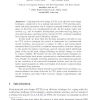Free Online Productivity Tools
i2Speak
i2Symbol
i2OCR
iTex2Img
iWeb2Print
iWeb2Shot
i2Type
iPdf2Split
iPdf2Merge
i2Bopomofo
i2Arabic
i2Style
i2Image
i2PDF
iLatex2Rtf
Sci2ools
ATVA
2015
Springer
2015
Springer
Lattice-Based Semantics for Combinatorial Model Evolution
Combinatorial test design (CTD) is an effective test design technique, considered to be a testing best practice. CTD provides automatic test plan generation, but it requires a manual definition of the test space in the form of a combinatorial model. As the system under test evolves, e.g., due to iterative development processes and bug fixing, so does the test space, and thus, in the context of CTD, evolution translates into frequent manual model definition updates. In this work, we show that the Boolean semantics currently in use by CTD tools to interpret the model is inadequate for combinatorial model evolution, and propose to replace it with a new lattice-based semantics that (1) provides a consistent interpretation of atomic changes to the model via Galois connections, and (2) exposes which additional parts of the model must change following an atomic change, in order to restore validity. We further use the new lattice-based semantics to define new higher-level atomic operation...
| Added | 16 Apr 2016 |
| Updated | 16 Apr 2016 |
| Type | Journal |
| Year | 2015 |
| Where | ATVA |
| Authors | Rachel Tzoref-Brill, Shahar Maoz |
Comments (0)

